Analysis of Data Collection Methods in the US: A Comprehensive Review
VerifiedAdded on 2023/06/15
|7
|1512
|207
Report
AI Summary
This report provides a detailed review of data collection methods in the United States, focusing on credit cards, social media, and online shopping. It examines the types of data collected, including first-party, second-party, and third-party data, and discusses the advantages and disadvantages for both companies and consumers. The report also outlines key data protection laws in the US, such as the Federal Trade Commission Act, HIPAA, and FCRA, highlighting the importance of careful data handling to prevent breaches and protect consumer privacy. The analysis concludes that a balanced approach to data collection is essential for maintaining consumer trust and ensuring ethical business practices.

Running head: REVIEW OF INFORMATION COLLECTION METHODS
Review of information collection methods
Name of the student
Name of the University
Author note
Review of information collection methods
Name of the student
Name of the University
Author note
Paraphrase This Document
Need a fresh take? Get an instant paraphrase of this document with our AI Paraphraser
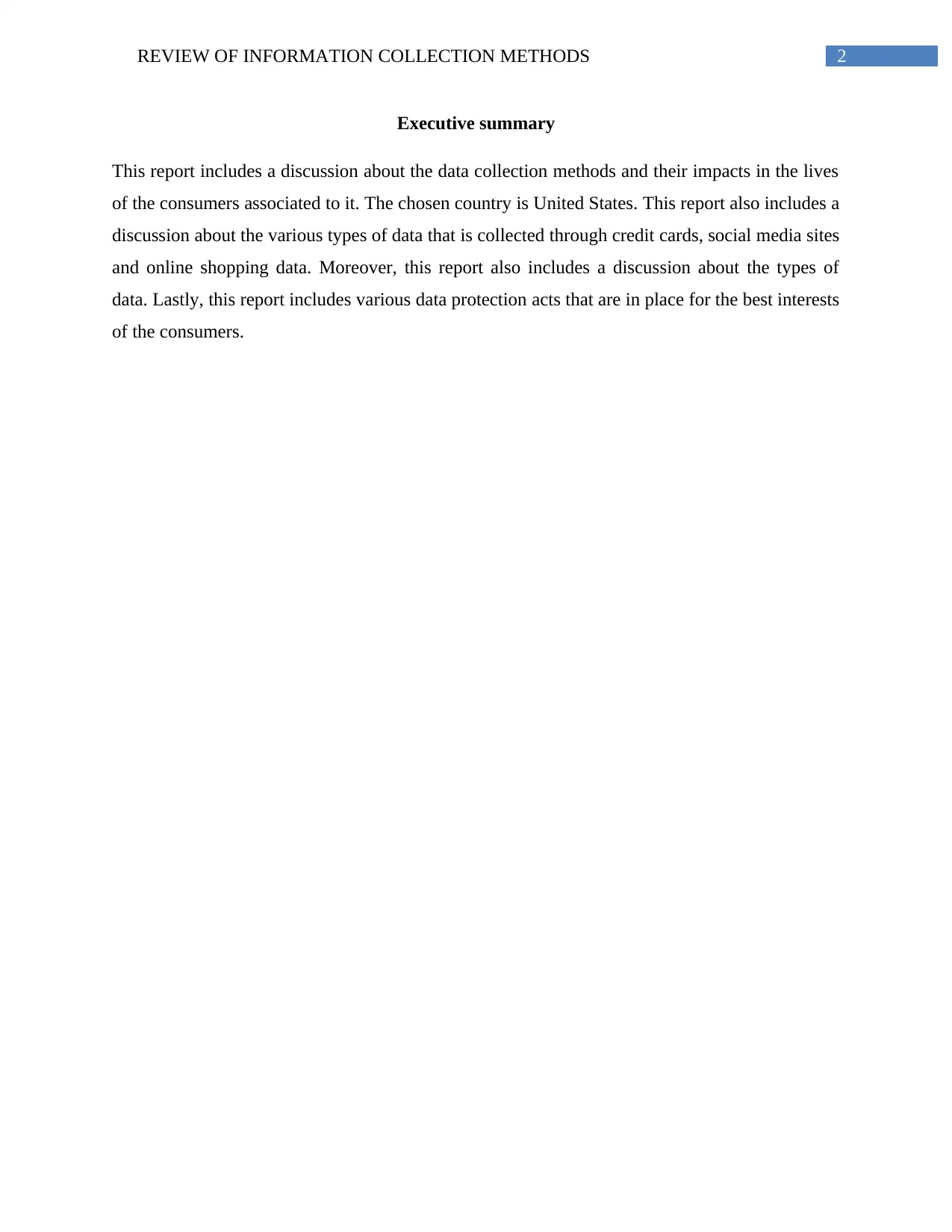
2REVIEW OF INFORMATION COLLECTION METHODS
Executive summary
This report includes a discussion about the data collection methods and their impacts in the lives
of the consumers associated to it. The chosen country is United States. This report also includes a
discussion about the various types of data that is collected through credit cards, social media sites
and online shopping data. Moreover, this report also includes a discussion about the types of
data. Lastly, this report includes various data protection acts that are in place for the best interests
of the consumers.
Executive summary
This report includes a discussion about the data collection methods and their impacts in the lives
of the consumers associated to it. The chosen country is United States. This report also includes a
discussion about the various types of data that is collected through credit cards, social media sites
and online shopping data. Moreover, this report also includes a discussion about the types of
data. Lastly, this report includes various data protection acts that are in place for the best interests
of the consumers.
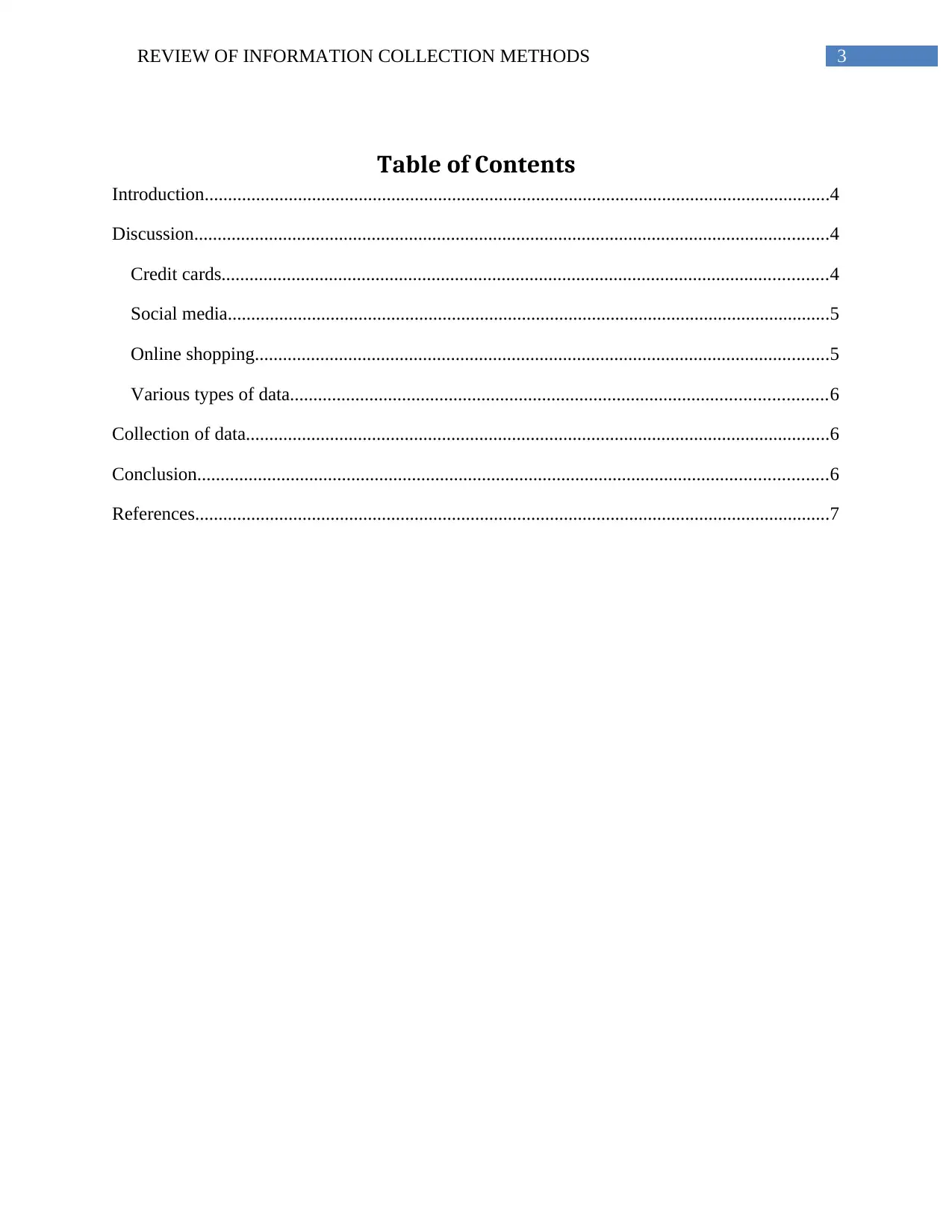
3REVIEW OF INFORMATION COLLECTION METHODS
Table of Contents
Introduction......................................................................................................................................4
Discussion........................................................................................................................................4
Credit cards..................................................................................................................................4
Social media.................................................................................................................................5
Online shopping...........................................................................................................................5
Various types of data...................................................................................................................6
Collection of data.............................................................................................................................6
Conclusion.......................................................................................................................................6
References........................................................................................................................................7
Table of Contents
Introduction......................................................................................................................................4
Discussion........................................................................................................................................4
Credit cards..................................................................................................................................4
Social media.................................................................................................................................5
Online shopping...........................................................................................................................5
Various types of data...................................................................................................................6
Collection of data.............................................................................................................................6
Conclusion.......................................................................................................................................6
References........................................................................................................................................7
⊘ This is a preview!⊘
Do you want full access?
Subscribe today to unlock all pages.

Trusted by 1+ million students worldwide
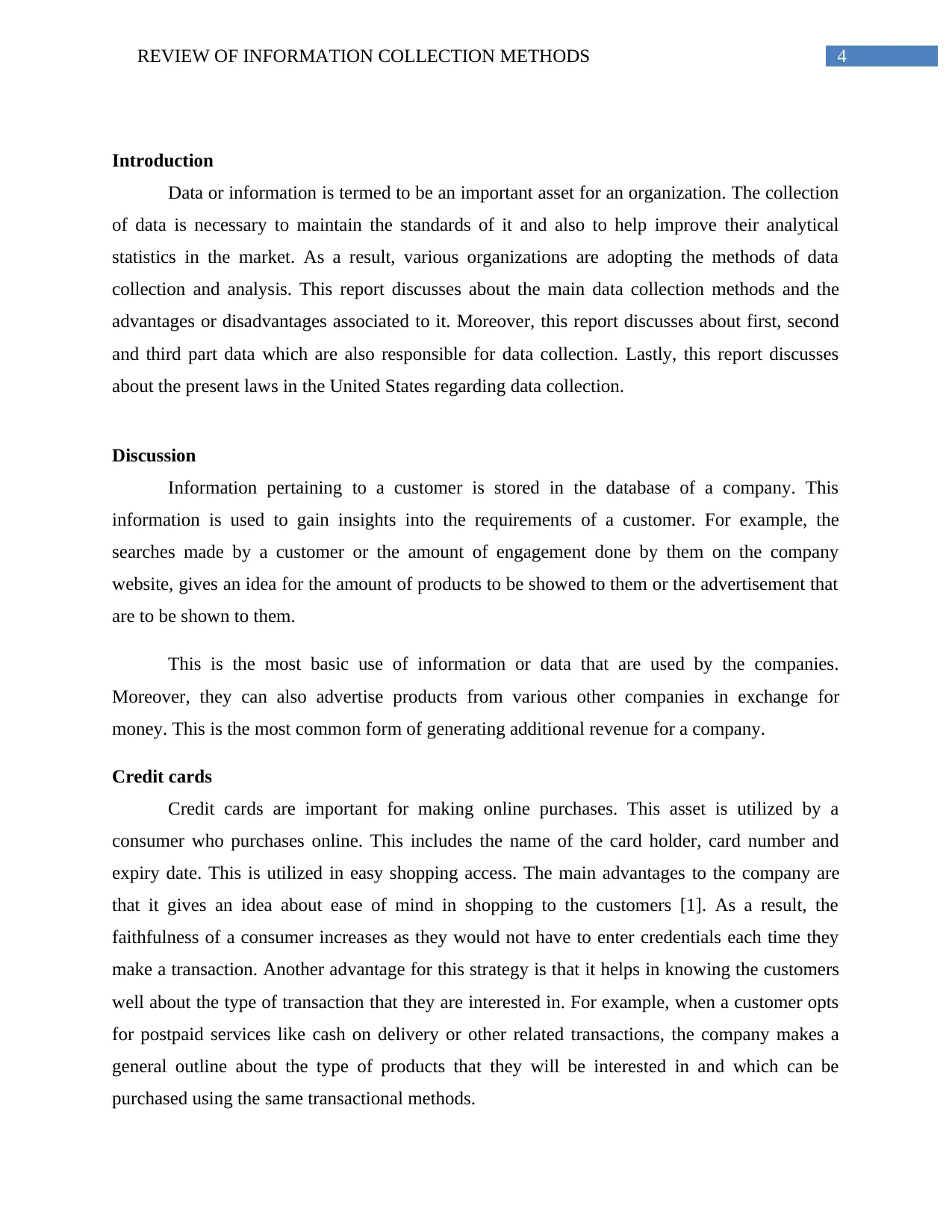
4REVIEW OF INFORMATION COLLECTION METHODS
Introduction
Data or information is termed to be an important asset for an organization. The collection
of data is necessary to maintain the standards of it and also to help improve their analytical
statistics in the market. As a result, various organizations are adopting the methods of data
collection and analysis. This report discusses about the main data collection methods and the
advantages or disadvantages associated to it. Moreover, this report discusses about first, second
and third part data which are also responsible for data collection. Lastly, this report discusses
about the present laws in the United States regarding data collection.
Discussion
Information pertaining to a customer is stored in the database of a company. This
information is used to gain insights into the requirements of a customer. For example, the
searches made by a customer or the amount of engagement done by them on the company
website, gives an idea for the amount of products to be showed to them or the advertisement that
are to be shown to them.
This is the most basic use of information or data that are used by the companies.
Moreover, they can also advertise products from various other companies in exchange for
money. This is the most common form of generating additional revenue for a company.
Credit cards
Credit cards are important for making online purchases. This asset is utilized by a
consumer who purchases online. This includes the name of the card holder, card number and
expiry date. This is utilized in easy shopping access. The main advantages to the company are
that it gives an idea about ease of mind in shopping to the customers [1]. As a result, the
faithfulness of a consumer increases as they would not have to enter credentials each time they
make a transaction. Another advantage for this strategy is that it helps in knowing the customers
well about the type of transaction that they are interested in. For example, when a customer opts
for postpaid services like cash on delivery or other related transactions, the company makes a
general outline about the type of products that they will be interested in and which can be
purchased using the same transactional methods.
Introduction
Data or information is termed to be an important asset for an organization. The collection
of data is necessary to maintain the standards of it and also to help improve their analytical
statistics in the market. As a result, various organizations are adopting the methods of data
collection and analysis. This report discusses about the main data collection methods and the
advantages or disadvantages associated to it. Moreover, this report discusses about first, second
and third part data which are also responsible for data collection. Lastly, this report discusses
about the present laws in the United States regarding data collection.
Discussion
Information pertaining to a customer is stored in the database of a company. This
information is used to gain insights into the requirements of a customer. For example, the
searches made by a customer or the amount of engagement done by them on the company
website, gives an idea for the amount of products to be showed to them or the advertisement that
are to be shown to them.
This is the most basic use of information or data that are used by the companies.
Moreover, they can also advertise products from various other companies in exchange for
money. This is the most common form of generating additional revenue for a company.
Credit cards
Credit cards are important for making online purchases. This asset is utilized by a
consumer who purchases online. This includes the name of the card holder, card number and
expiry date. This is utilized in easy shopping access. The main advantages to the company are
that it gives an idea about ease of mind in shopping to the customers [1]. As a result, the
faithfulness of a consumer increases as they would not have to enter credentials each time they
make a transaction. Another advantage for this strategy is that it helps in knowing the customers
well about the type of transaction that they are interested in. For example, when a customer opts
for postpaid services like cash on delivery or other related transactions, the company makes a
general outline about the type of products that they will be interested in and which can be
purchased using the same transactional methods.
Paraphrase This Document
Need a fresh take? Get an instant paraphrase of this document with our AI Paraphraser
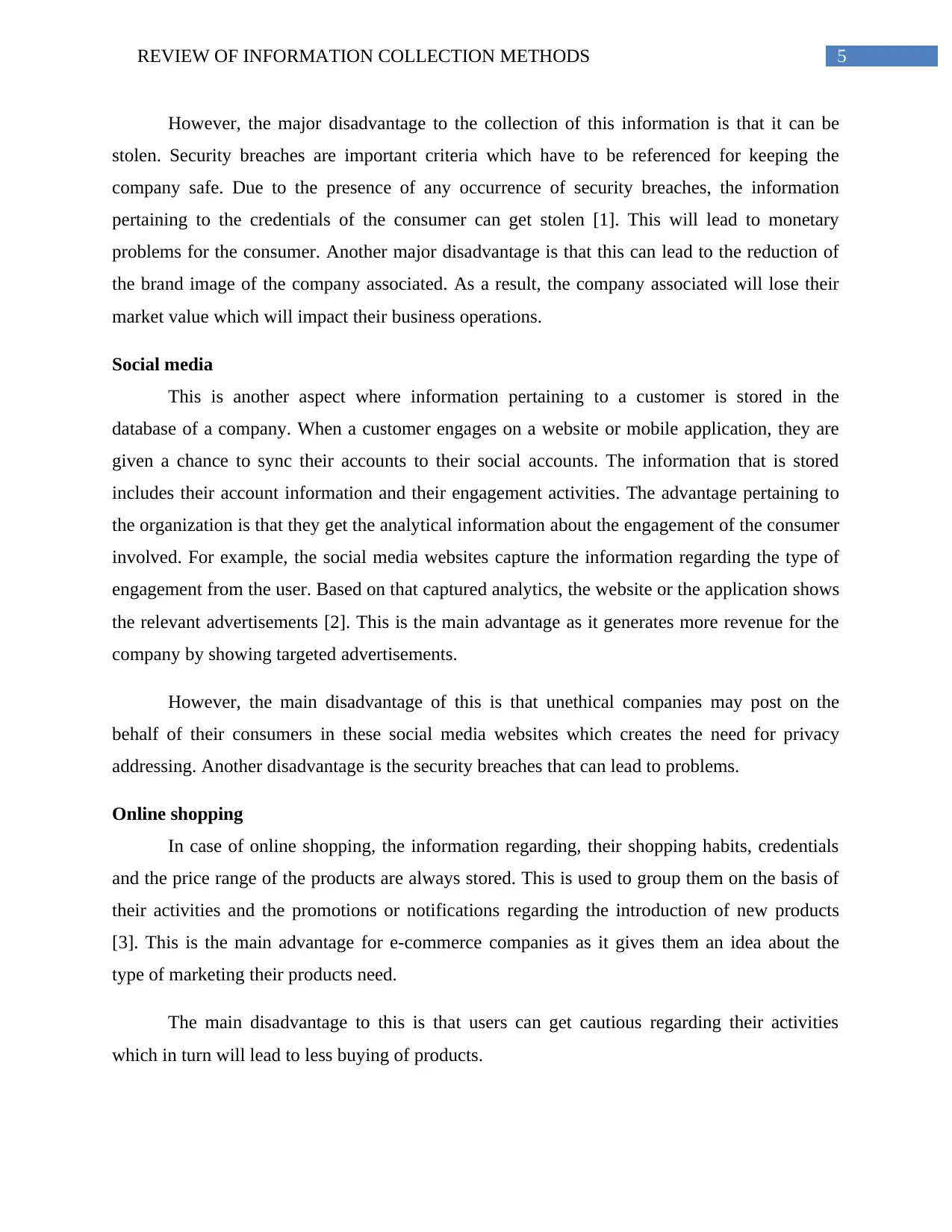
5REVIEW OF INFORMATION COLLECTION METHODS
However, the major disadvantage to the collection of this information is that it can be
stolen. Security breaches are important criteria which have to be referenced for keeping the
company safe. Due to the presence of any occurrence of security breaches, the information
pertaining to the credentials of the consumer can get stolen [1]. This will lead to monetary
problems for the consumer. Another major disadvantage is that this can lead to the reduction of
the brand image of the company associated. As a result, the company associated will lose their
market value which will impact their business operations.
Social media
This is another aspect where information pertaining to a customer is stored in the
database of a company. When a customer engages on a website or mobile application, they are
given a chance to sync their accounts to their social accounts. The information that is stored
includes their account information and their engagement activities. The advantage pertaining to
the organization is that they get the analytical information about the engagement of the consumer
involved. For example, the social media websites capture the information regarding the type of
engagement from the user. Based on that captured analytics, the website or the application shows
the relevant advertisements [2]. This is the main advantage as it generates more revenue for the
company by showing targeted advertisements.
However, the main disadvantage of this is that unethical companies may post on the
behalf of their consumers in these social media websites which creates the need for privacy
addressing. Another disadvantage is the security breaches that can lead to problems.
Online shopping
In case of online shopping, the information regarding, their shopping habits, credentials
and the price range of the products are always stored. This is used to group them on the basis of
their activities and the promotions or notifications regarding the introduction of new products
[3]. This is the main advantage for e-commerce companies as it gives them an idea about the
type of marketing their products need.
The main disadvantage to this is that users can get cautious regarding their activities
which in turn will lead to less buying of products.
However, the major disadvantage to the collection of this information is that it can be
stolen. Security breaches are important criteria which have to be referenced for keeping the
company safe. Due to the presence of any occurrence of security breaches, the information
pertaining to the credentials of the consumer can get stolen [1]. This will lead to monetary
problems for the consumer. Another major disadvantage is that this can lead to the reduction of
the brand image of the company associated. As a result, the company associated will lose their
market value which will impact their business operations.
Social media
This is another aspect where information pertaining to a customer is stored in the
database of a company. When a customer engages on a website or mobile application, they are
given a chance to sync their accounts to their social accounts. The information that is stored
includes their account information and their engagement activities. The advantage pertaining to
the organization is that they get the analytical information about the engagement of the consumer
involved. For example, the social media websites capture the information regarding the type of
engagement from the user. Based on that captured analytics, the website or the application shows
the relevant advertisements [2]. This is the main advantage as it generates more revenue for the
company by showing targeted advertisements.
However, the main disadvantage of this is that unethical companies may post on the
behalf of their consumers in these social media websites which creates the need for privacy
addressing. Another disadvantage is the security breaches that can lead to problems.
Online shopping
In case of online shopping, the information regarding, their shopping habits, credentials
and the price range of the products are always stored. This is used to group them on the basis of
their activities and the promotions or notifications regarding the introduction of new products
[3]. This is the main advantage for e-commerce companies as it gives them an idea about the
type of marketing their products need.
The main disadvantage to this is that users can get cautious regarding their activities
which in turn will lead to less buying of products.
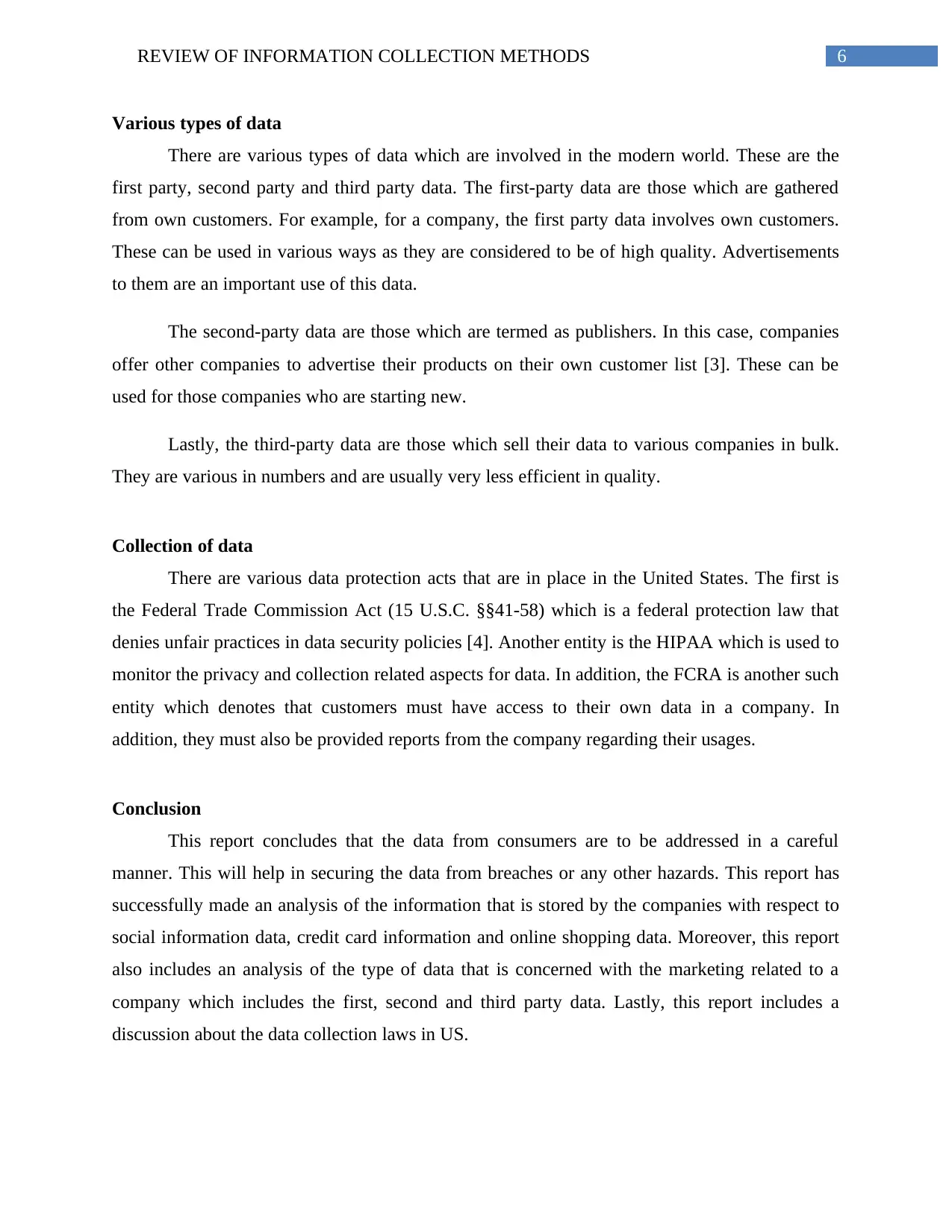
6REVIEW OF INFORMATION COLLECTION METHODS
Various types of data
There are various types of data which are involved in the modern world. These are the
first party, second party and third party data. The first-party data are those which are gathered
from own customers. For example, for a company, the first party data involves own customers.
These can be used in various ways as they are considered to be of high quality. Advertisements
to them are an important use of this data.
The second-party data are those which are termed as publishers. In this case, companies
offer other companies to advertise their products on their own customer list [3]. These can be
used for those companies who are starting new.
Lastly, the third-party data are those which sell their data to various companies in bulk.
They are various in numbers and are usually very less efficient in quality.
Collection of data
There are various data protection acts that are in place in the United States. The first is
the Federal Trade Commission Act (15 U.S.C. §§41-58) which is a federal protection law that
denies unfair practices in data security policies [4]. Another entity is the HIPAA which is used to
monitor the privacy and collection related aspects for data. In addition, the FCRA is another such
entity which denotes that customers must have access to their own data in a company. In
addition, they must also be provided reports from the company regarding their usages.
Conclusion
This report concludes that the data from consumers are to be addressed in a careful
manner. This will help in securing the data from breaches or any other hazards. This report has
successfully made an analysis of the information that is stored by the companies with respect to
social information data, credit card information and online shopping data. Moreover, this report
also includes an analysis of the type of data that is concerned with the marketing related to a
company which includes the first, second and third party data. Lastly, this report includes a
discussion about the data collection laws in US.
Various types of data
There are various types of data which are involved in the modern world. These are the
first party, second party and third party data. The first-party data are those which are gathered
from own customers. For example, for a company, the first party data involves own customers.
These can be used in various ways as they are considered to be of high quality. Advertisements
to them are an important use of this data.
The second-party data are those which are termed as publishers. In this case, companies
offer other companies to advertise their products on their own customer list [3]. These can be
used for those companies who are starting new.
Lastly, the third-party data are those which sell their data to various companies in bulk.
They are various in numbers and are usually very less efficient in quality.
Collection of data
There are various data protection acts that are in place in the United States. The first is
the Federal Trade Commission Act (15 U.S.C. §§41-58) which is a federal protection law that
denies unfair practices in data security policies [4]. Another entity is the HIPAA which is used to
monitor the privacy and collection related aspects for data. In addition, the FCRA is another such
entity which denotes that customers must have access to their own data in a company. In
addition, they must also be provided reports from the company regarding their usages.
Conclusion
This report concludes that the data from consumers are to be addressed in a careful
manner. This will help in securing the data from breaches or any other hazards. This report has
successfully made an analysis of the information that is stored by the companies with respect to
social information data, credit card information and online shopping data. Moreover, this report
also includes an analysis of the type of data that is concerned with the marketing related to a
company which includes the first, second and third party data. Lastly, this report includes a
discussion about the data collection laws in US.
⊘ This is a preview!⊘
Do you want full access?
Subscribe today to unlock all pages.

Trusted by 1+ million students worldwide
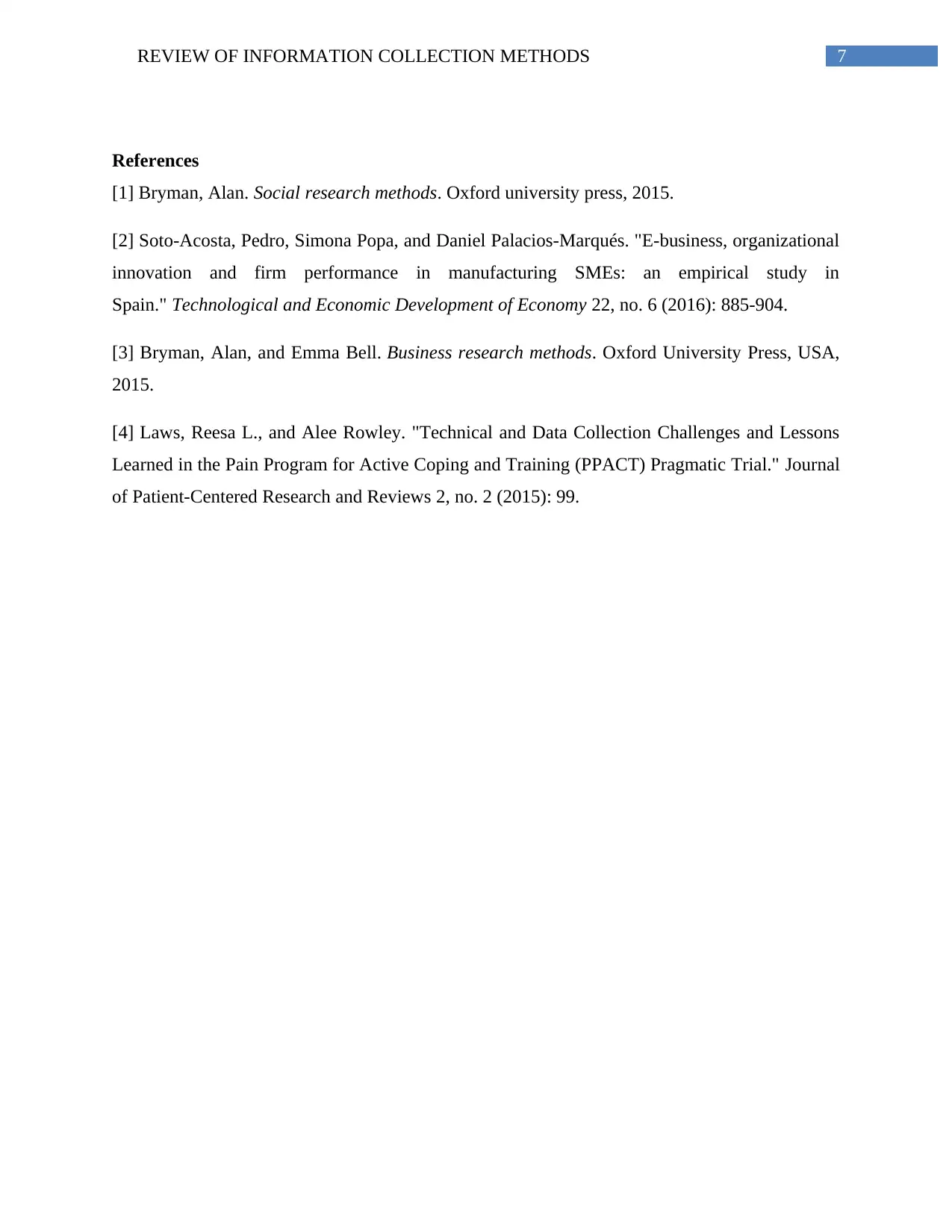
7REVIEW OF INFORMATION COLLECTION METHODS
References
[1] Bryman, Alan. Social research methods. Oxford university press, 2015.
[2] Soto-Acosta, Pedro, Simona Popa, and Daniel Palacios-Marqués. "E-business, organizational
innovation and firm performance in manufacturing SMEs: an empirical study in
Spain." Technological and Economic Development of Economy 22, no. 6 (2016): 885-904.
[3] Bryman, Alan, and Emma Bell. Business research methods. Oxford University Press, USA,
2015.
[4] Laws, Reesa L., and Alee Rowley. "Technical and Data Collection Challenges and Lessons
Learned in the Pain Program for Active Coping and Training (PPACT) Pragmatic Trial." Journal
of Patient-Centered Research and Reviews 2, no. 2 (2015): 99.
References
[1] Bryman, Alan. Social research methods. Oxford university press, 2015.
[2] Soto-Acosta, Pedro, Simona Popa, and Daniel Palacios-Marqués. "E-business, organizational
innovation and firm performance in manufacturing SMEs: an empirical study in
Spain." Technological and Economic Development of Economy 22, no. 6 (2016): 885-904.
[3] Bryman, Alan, and Emma Bell. Business research methods. Oxford University Press, USA,
2015.
[4] Laws, Reesa L., and Alee Rowley. "Technical and Data Collection Challenges and Lessons
Learned in the Pain Program for Active Coping and Training (PPACT) Pragmatic Trial." Journal
of Patient-Centered Research and Reviews 2, no. 2 (2015): 99.
1 out of 7
Related Documents
Your All-in-One AI-Powered Toolkit for Academic Success.
+13062052269
info@desklib.com
Available 24*7 on WhatsApp / Email
![[object Object]](/_next/static/media/star-bottom.7253800d.svg)
Unlock your academic potential
Copyright © 2020–2025 A2Z Services. All Rights Reserved. Developed and managed by ZUCOL.





